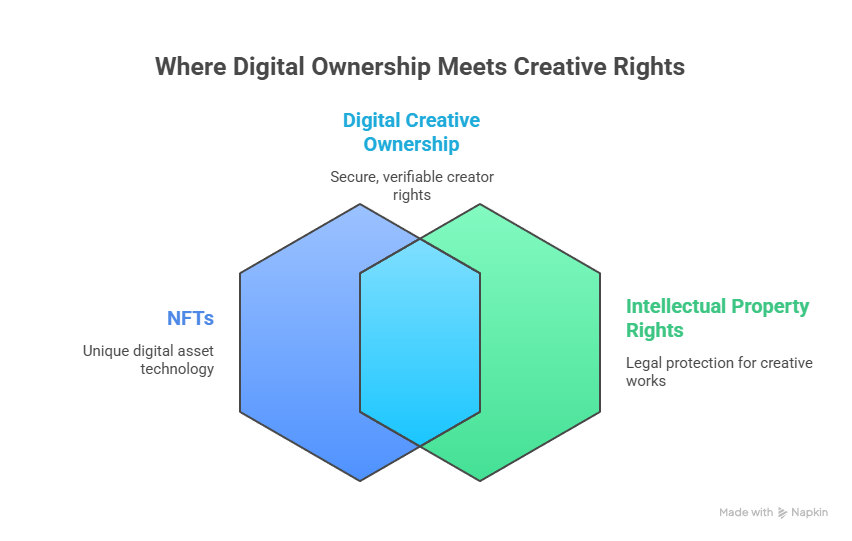In recent years, Non-Fungible Tokens (NFTs) have transitioned from obscure blockchain experiments to mainstream digital assets. What began as a novel way to sell digital art has evolved into a billion-dollar industry touching everything from luxury fashion and sports franchises to music, gaming, and digital real estate.
Brands like Gucci, Nike, and even football clubs like Manchester City have begun launching their own NFT collections. But beneath the glamour and speculation lies a complex and still-unfolding legal terrain—particularly in the area of Intellectual Property Rights (IPRs).
NFTs and Intellectual Property Rights are intertwined. NFTs represent ownership of digital assets, subject to copyright, trademark, and more!
What Are NFTs, Really?
The World Intellectual Property Organization (WIPO) describes tokenization as one of the most promising uses of blockchain technology.
In essence, NFTs are unique, programmable digital assets stored on a blockchain, each containing metadata that distinguishes it from any other token. Unlike cryptocurrencies such as Bitcoin or Ethereum (which are fungible and identical), NFTs are non-fungible, meaning they are one-of-a-kind.
Think of an NFT as a digital certificate of authenticity for a piece of art, a video clip, a virtual sneaker, or even a tweet. This uniqueness makes NFTs valuable—but also brings serious questions regarding legal ownership, reproduction rights, and intellectual property into focus.
The Legal Paradox: Ownership vs. Intellectual Property

Owning an NFT does not necessarily mean you own the underlying intellectual property rights associated with the digital asset. This distinction is not always clear to consumers—and it’s becoming a hotbed of confusion and litigation.
When you buy a painting in the real world, you own the canvas, but not the right to reproduce or commercialize the artwork. The same principle applies to NFTs. What most users are buying is a license to view or display the digital asset, not the copyright itself—unless explicitly transferred.
Common Misconception:
“I own the NFT, so I own the art.”
Not quite. You own the token, not necessarily the content it points to. Unless the creator has transferred copyright ownership or granted a commercial license, you cannot legally reproduce, modify, or sell the underlying work beyond the terms set in the smart contract or licensing agreement.
Intellectual Property Rights and NFTs: The Legal Intersection
1. Copyright
Most NFTs are creative works—digital art, videos, music. This automatically triggers copyright protection, which gives the creator exclusive rights to reproduce, distribute, or modify the work.
- Problem: The buyer of an NFT often gets no more than display rights, while the creator retains copyright. If this is not clearly communicated, it leads to legal confusion.
- Key Case Example: In Hermès v. Rothschild, Hermès sued the creator of “MetaBirkins” NFTs for trademark infringement, raising questions about artistic freedom vs. brand protection.
2. Trademark
Brands like Balenciaga, Adidas, and Nike are using NFTs for digital merchandise. This means their trademarks (logos, product names) are entering virtual marketplaces.
- Concern: Unauthorized NFT creators may mint works using protected trademarks, misleading consumers and diluting brand identity.
- Legal Gap: Most trademark laws are still rooted in physical goods and services. There is a pressing need to address trademark use in virtual and metaverse environments.
3. Patents
Though not as immediately relevant to NFT content, blockchain infrastructure and NFT-related technology can involve patentable innovations. Companies developing NFT platforms or virtual reality integrations may hold patents on the tech architecture, which brings up licensing and enforcement issues.
Who Protects the IPR in the NFT Ecosystem?
This is a crucial question—and one the law is still grappling with.
Currently, it’s the responsibility of the NFT creator to ensure that they own or have licensed the rights to tokenize the work. However, marketplaces like OpenSea, Rarible, and Foundation are under increasing pressure to enforce IPR protections, especially when takedown notices arise under the DMCA (Digital Millennium Copyright Act).
But enforcement remains weak, and jurisdictional uncertainty makes litigation difficult. If an NFT is minted in India, bought in the US, and hosted on a server in Singapore, which country’s IPR laws apply? There’s no uniform answer—yet.
Are Existing Laws Sufficient?
Short answer: No.
While traditional IP laws provide baseline protections, they were not designed with decentralized, blockchain-based assets in mind. Some of the key limitations include:
- Lack of clarity on digital ownership and rights transfer
- Inconsistent licensing agreements in smart contracts
- No global framework for cross-border enforcement
- Difficulties in identifying infringers due to pseudonymity on blockchain
Countries like the US, EU, and India are beginning to acknowledge these challenges, but regulatory action is still at an early stage.
Where Does India Stand?
India has no specific legislation dealing with NFTs as of now. However, NFTs fall under a grey area governed by:
- The Copyright Act, 1957
- The Trademarks Act, 1999
- Information Technology Act, 2000
- Consumer Protection (E-Commerce) Rules, 2020 (possibly applicable to NFT marketplaces)
Indian courts have yet to deliver a definitive ruling on NFTs and IP, but given the pace of digital innovation and investment in NFTs by Indian creators and celebrities, legal scrutiny is inevitable.
Conclusion
NFTs are more than a trend. They represent a new form of digital expression, ownership, and commerce. But with innovation comes complexity. The relationship between NFTs and Intellectual Property Rights is not merely academic—it’s a legal minefield waiting to be mapped.
For buyers: Know what you’re buying. Read the terms. Don’t assume ownership of copyright unless explicitly granted.
For creators: Understand the rights you hold—and the ones you’re transferring. Use smart contracts and licensing terms carefully.
For regulators: Adapt fast. Digital ownership is here to stay, and the law must evolve to protect creators, consumers, and businesses alike.
As the line between physical and digital assets continues to blur, IPR frameworks must expand their scope. Until then, caution, clarity, and contractual precision will be your best legal defense in the world of NFTs.




